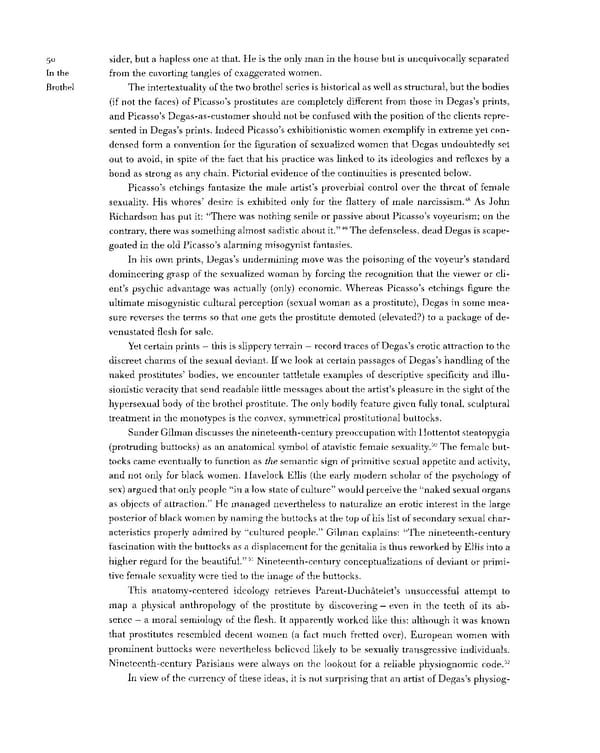5o sider, but a hapless one at that. He is the only man in the house but is unequivocally separated In the from the cavorting tangles of exaggerated women. Brothel The intertextuality of the two brothel series is historical as well as structural, but the bodies (if not the faces) of Picasso's prostitutes are completely different from those in Degas's prints, and Picasso's Degas-as-customer should not be confused with the position of the clients repre- sented in Degas's prints. Indeed Picasso's exhibitionistic women exemplify in extreme yet con- densed form a convention for the figuration of sexualized women that Degas undoubtedly set out to avoid, in spite of the fact that his practice was linked to its ideologies and reflexes by a bond as strong as any chain. Pictorial evidence of the continuities is presented below. Picasso's etchings fantasize the male artist's proverbial control over the threat of female 48 sexuality. His whores' desire is exhibited only for the flattery of male narcissism. As John Richardson has put it: "There was nothing senile or passive about Picasso's voyeurism; on the 49 contrary, there was something almost sadistic about it." The defenseless, dead Degas is scape- goated in the old Picasso's alarming misogynist fantasies. In his own prints, Degas's undermining move was the poisoning of the voyeur's standard domineering grasp of the sexualized woman by forcing the recognition that the viewer or cli- ent's psychic advantage was actually (only) economic. Whereas Picasso's etchings figure the ultimate misogynistic cultural perception (sexual woman as a prostitute), Degas in some mea- sure reverses the terms so that one gets the prostitute demoted (elevated?) to a package of de- venustated flesh for sale. Yet certain prints — this is slippery terrain — record traces of Degas's erotic attraction to the discreet charms of the sexual deviant. If we look at certain passages of Degas's handling of the naked prostitutes' bodies, we encounter tattletale examples of descriptive specificity and illu- sionistic veracity that send readable little messages about the artist's pleasure in the sight of the hypersexual body of the brothel prostitute. The only bodily feature given fully tonal, sculptural treatment in the monotypes is the convex, symmetrical prostitutional buttocks. Sander Oilman discusses the nineteenth-century preoccupation with Hottentot steatopygia 50 (protruding buttocks) as an anatomical symbol of atavistic female sexuality. The female but- tocks came eventually to function as the semantic sign of primitive sexual appetite and activity, and not only for black women. Havelock Ellis (the early modern scholar of the psychology of sex) argued that only people "in a low state of culture" would perceive the "naked sexual organs as objects of attraction." He managed nevertheless to naturalize an erotic interest in the large posterior of black women by naming the buttocks at the top of his list of secondary sexual char- acteristics properly admired by "cultured people." Oilman explains: "The nineteenth-century fascination with the buttocks as a displacement for the genitalia is thus reworked by Ellis into a 51 higher regard for the beautiful." Nineteenth-century conceptualizations of deviant or primi- tive female sexuality were tied to the image of the buttocks. This anatomy-centered ideology retrieves Parent-Duchatelet's unsuccessful attempt to map a physical anthropology of the prostitute by discovering - even in the teeth of its ab- sence — a moral semiology of the flesh. It apparently worked like this: although it was known that prostitutes resembled decent women (a fact much fretted over), European women with prominent buttocks were nevertheless believed likely to be sexually transgressive individuals. Nineteenth-century Parisians were always on the lookout for a reliable physiognomic code.52 In view of the currency of these ideas, it is not surprising that an artist of Degas's physiog-
 Prostitution & Impressionists Page 70 Page 72
Prostitution & Impressionists Page 70 Page 72